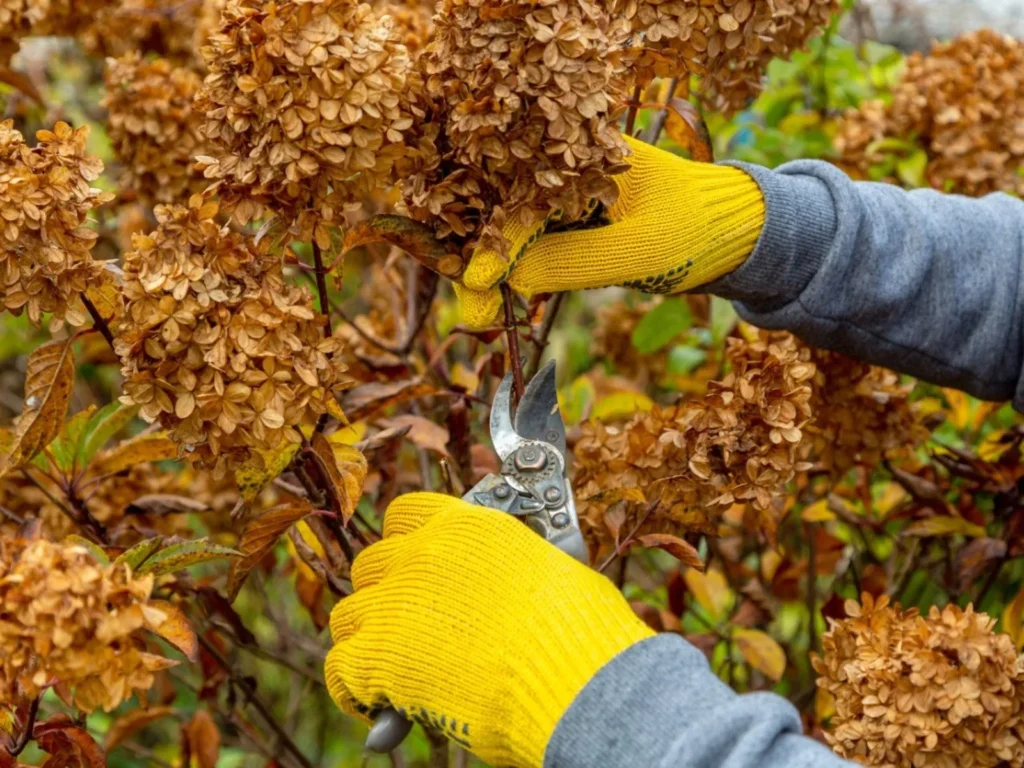If you’ve ever stood in front of your hydrangeas wondering why they didn’t bloom this year, you’re not alone.
Many gardeners, new and seasoned, make the same quiet mistake: pruning at the wrong time.
It sounds small, but it’s the difference between a full, dreamy burst of flowers and a green bush with zero color.
Here’s the thing: hydrangeas aren’t just “set it and forget it” plants. They’re a little moody, a little misunderstood, but oh-so-worth it when they bloom.
Pruning them correctly isn’t about rigid gardening rules, it’s about timing, intuition, and knowing your plant’s rhythm.
Think of pruning like a good haircut. Do it right, and your hydrangea looks fuller, fresher, and healthier.
Do it wrong, and you’ll be stuck watching your neighbor’s hydrangeas steal the spotlight all summer long.
This guide breaks everything down clearly, what type of hydrangea you have, when to prune it, and how to keep it happy without overthinking it.
And yes, I’ll share a few of my favorite pruning tools too (because dull shears are the real enemy of a clean cut).

Why Pruning Hydrangeas Matters (More Than You Think)
Let’s be honest, most people prune hydrangeas because they look messy. But there’s a deeper reason pruning matters, one that directly ties to how these plants grow and bloom.
Hydrangeas rely on energy balance. When they spend too much energy on dead or old stems, they produce fewer flowers.
When they’re shaped properly, air flows better, sunlight reaches inner leaves, and the plant focuses on what really matters: blooms.
Pruning is also about health. Dead branches invite mold, pests, and rot. Removing them keeps your hydrangea disease-free and strong enough to face harsh winters or scorching summers.
And then there’s the emotional side. It feels good to prune, a little therapeutic, right? There’s something satisfying about clearing away what’s no longer serving the plant and making space for new growth.
It’s one of those simple tasks that give you both immediate results and long-term rewards.
Here’s a fun analogy: pruning hydrangeas is like editing a good story. You don’t cut for the sake of cutting; you trim what doesn’t belong so the real beauty can shine through.
The Golden Rule: Know Your Type Before You Cut
Before you even think about reaching for those shears, you have to know what kind of hydrangea you’re working with.
That’s the number one rule, and it’s where most pruning disasters start.
Hydrangeas fall into two main categories—old wood and new wood bloomers—and this little detail completely changes when and how you should prune.
Here’s how to tell them apart (even if you’ve lost the tag that came with the plant):
Old Wood Bloomers
These hydrangeas bloom on stems that grew the previous year. That means if you cut them in late fall, winter, or early spring, you’re literally removing next year’s flowers.
Common types:
- Bigleaf Hydrangea (Hydrangea macrophylla)—those classic round, fluffy blooms everyone loves.
- Oakleaf Hydrangea (Hydrangea quercifolia) – cone-shaped blooms with large, textured leaves that turn gorgeous shades in fall.
- Mountain Hydrangea (Hydrangea serrata)—smaller, lace-like flowers that handle cold better.
- Climbing Hydrangea (Hydrangea anomala petiolaris) – spreads beautifully on walls or trellises and flowers on old stems.
You’ll prune these right after they finish blooming, never before spring.
New Wood Bloomers
These types are much easier to handle because they bloom on fresh growth each year. You can prune them hard in late winter or early spring, and they’ll still bloom beautifully.
Common types:
- Smooth Hydrangea (Hydrangea arborescens)—includes ‘Annabelle’ and ‘Incrediball’ varieties with big, white snowball flowers.
- Panicle Hydrangea (Hydrangea paniculata)—known for cone-shaped blooms like ‘Limelight,’ ‘Bobo,’ or ‘Little Lime.’
You can safely prune these while the plant’s dormant (usually February or March) to encourage stronger, fuller growth in summer.
Tip: If you’re unsure which you have
Watch when it blooms. If your hydrangea flowers early (late spring to early summer), it’s probably an old wood type. If it blooms mid- to late summer, it’s most likely a new wood type.
And if you bought a reblooming variety like Endless Summer, it’s a mix of both, it’ll flower on old and new growth, giving you a little more flexibility (but we’ll talk about that later).
When to Prune Old Wood Hydrangeas
Here’s where things get tricky—but once you get it, it becomes second nature.
Old wood hydrangeas (like Bigleaf, Oakleaf, Mountain, and Climbing varieties) grow their flower buds during late summer and fall. So if you prune them in winter or early spring, you’ll cut off those developing buds before they ever have a chance to bloom.
That’s why timing is everything here.
The best time to prune old wood hydrangeas is right after they finish blooming, usually around July through early August depending on your region. Once those flowers fade, you have a small window—just a few weeks—before next year’s buds begin forming.
Here’s a simple pruning plan:
- Cut the spent blooms just above a healthy pair of leaves or buds.
- Remove one-third of the oldest stems at the base to encourage new shoots.
- Thin out crowded growth to improve air circulation.
- Leave young, strong stems since they’ll produce next season’s flowers.
And don’t worry about being perfect. Hydrangeas are forgiving if you make small mistakes—just don’t prune too late into fall. A common rule of thumb? If you’re pulling out Halloween decorations, it’s already too late to prune old wood hydrangeas.
Helpful tools:
- Pruning Shears – Check on Amazon
- Lightweight Gardening Gloves – Check on Amazon
When to Prune New Wood Hydrangeas
Now, if you’re lucky enough to have new wood bloomers like Annabelle or Limelight, life gets easier.
These hydrangeas form buds on new growth each spring, which means they’re much more flexible about pruning time.
The ideal window to prune new wood hydrangeas is late winter to early spring, just before new growth starts, think February to March in most climates.
How much should you cut? It depends on what you want:
- For bigger blooms, cut the stems down to about 12–18 inches from the ground.
- For smaller, more numerous flowers, just trim about one-third of the plant.
Every few years, it’s good to do a rejuvenation prune—cutting all stems nearly to the ground to refresh the plant. This works wonders for old, leggy hydrangeas that haven’t bloomed well in a while.
Tip: Always use sharp, clean tools. Dirty or dull blades crush stems, which can lead to disease. A simple wipe with rubbing alcohol before you start pruning is enough to keep things sanitary.
Product suggestions:
- Extendable Lopper for thick stems – Check on Amazon
- Disinfectant Spray for garden tools – Check on Amazon
Special Section: Reblooming Varieties (Both Old and New Wood)
Reblooming hydrangeas like the Endless Summer series are the best of both worlds. They flower on both old and new wood, giving you a second chance if you prune too early or too late. But that doesn’t mean they’re maintenance-free.
For rebloomers, less is more. Heavy pruning can reduce the number of blooms, especially early-season ones that grow on old wood.
Here’s the sweet spot:
- After the first flush of blooms fades (mid-summer), snip off the spent flowers just above a healthy leaf node.
- In late winter or early spring, lightly remove any dead or weak stems—but don’t cut too deep.
It’s more about shaping and refreshing rather than cutting back hard.
A gentle deadheading routine throughout the season encourages continuous blooming. Just snip the flowers once they fade, and the plant will reward you with fresh color well into fall.
If you live in colder areas, protect the base of reblooming hydrangeas with a thick mulch layer or garden fleece through winter. Those buds on the old wood need warmth to survive frost.
Recommended tools and supplies:
- Garden Mulch – Check on Amazon
- Pruning Snips for deadheading – Check on Amazon
- Frost Protection Cover – Check on Amazon

